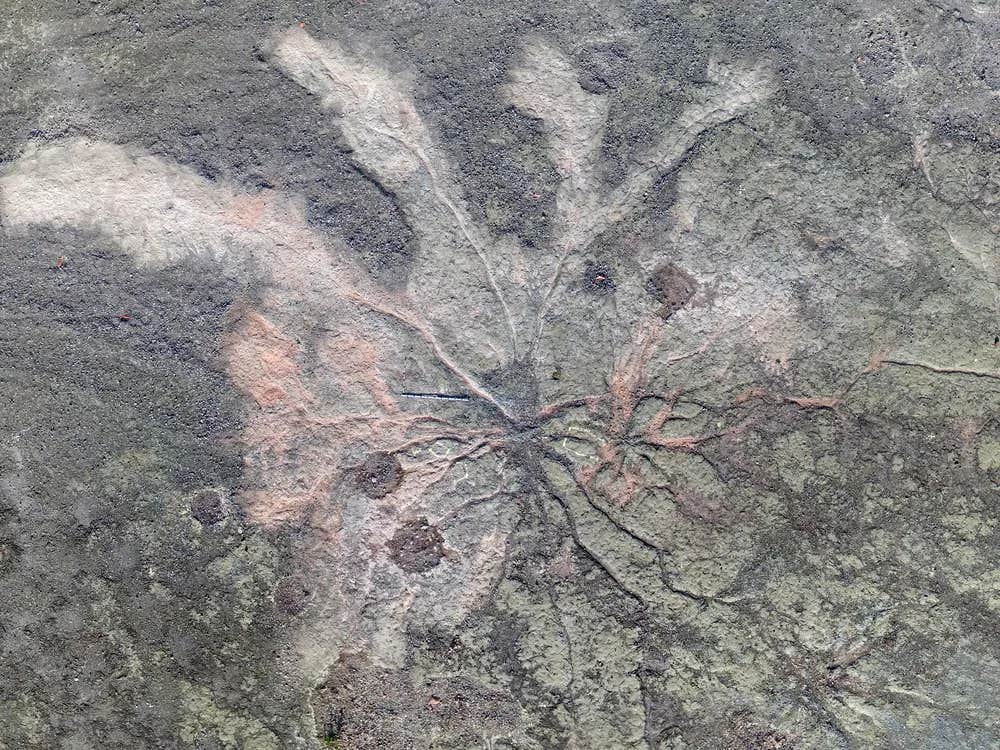Scientists discover the world’s oldest forest dating back 385 million years
Researchers have mapped out the world’s oldest forest that predates the famous Gilboa fossil forest by two million years.

An aerial view of a fossil of Archaeopteris, a 385-million-year-old tree with surprisingly modern-looking roots. (CREDIT: William Stein and Christopher Berry)
In 2009, while examining an old quarry, Charles Ver Straeten, the curator of sedimentary rocks at the New York State Museum, noticed something unusual. He was scouting the area with colleagues Linda Van Aller Hernick and Frank Mannolini, planning a potential field trip.
Although paleobotanists have explored the former highway department property since the 1960s, something different caught Ver Straeten's attention. His trained eye spotted wandering gutters in the stone—features typically found in marine rocks. But this land, even during the Middle Devonian period, was never submerged under the sea.
As Ver Straeten traced eleven of the lines, they all converged at a single point. It was then that he realized these lines were the roots of an ancient, massive tree, dating back to a time when forests were still a novel feature on Earth. Through meticulous study, researchers have mapped out the world's oldest forest, tree by tree, in this area—an ancient forest that predates the famous Gilboa fossil forest by two million years.
The Cairo site, as it's known, has been carefully guarded by researchers from Binghamton University and beyond, to protect it from fossil hunters and other potential damage. But this protection may not last forever. Thanks to New York State Senator Michelle Hinchey, the town secured a $170,000 grant to build specialized fencing around the property, supported by concrete barriers, to safeguard the fossil forest below.
Joe Hasenkopf, the chair of the Cairo Planning Board, mentioned that the next step involves conducting a feasibility study. This study will explore the possibility of creating an educational center and working lab on-site, which would benefit researchers, students, and the public alike.
In a recent development, the state government passed a law establishing a New York state geological trail and geopark system. Cairo is expected to be one of the first parks in this new system, opening up additional funding opportunities for the future. Researchers believe that by preserving this site, future scientists and students will have a unique opportunity to explore and learn from these ancient root impressions.
Khudadad, who earned a doctorate in biological sciences from Binghamton University, emphasized the significance of this preservation. “The in-situ preserved forest floors such as the one in the Town of Cairo are the rarest fossil records. Its preservation is a great contribution to the study of the evolution of early trees, forest ecosystems, past climates and landscapes, and possibly the earliest land animals,” he explained. “There are plenty of unanswered questions that need to be investigated by current and future scientists, and such preservation attempts are definitely a great gift to future generations.”
Related Stories
For those eager to learn about this ancient forest without waiting for the educational center, the Gilboa Historical Society released a book in July titled The Catskill Fossil Forest. This book traces the history of the ancient forest from its initial discovery in the 1800s through the construction of the Schoharie Dam and up to the current research in Gilboa, Conesville, and Cairo.
Co-authored by Emeritus Professor of Biological Sciences William Stein, along with Van Aller Hernick and Mannolini, the book not only explains the scientific significance of the forest but also features lavish illustrations and photos of digs. Sales from the book benefit the Gilboa Museum and Juried History Center, key supporters of research at the Cairo and Gilboa sites.
Stein elaborated on the importance of these sites, noting that the Cairo and Gilboa locations, along with Conesville, which is somewhat younger, likely represent different aspects of the same forest that persisted for millions of years in the Catskill region. “These sites together currently record the best evidence worldwide of forests during this time period,” Stein said.
The Gilboa site was first called the “world’s oldest forest” in the 1920s, thanks to the New York State Museum’s Winifred Goldring. However, the Cairo site, at 387 million years old, is slightly older than Gilboa. Both sites are unique in preserving the root systems of individual trees within ancient soil. These root structures, akin to dinosaur footprints, offer scientists a glimpse into the behavior of living organisms—specifically, ancient forest ecology.
Since the 1920s, knowledge about these ancient forests has advanced. Researchers now have a better understanding of the composition and structure of these forests and their impact on global processes such as climate, river geometry, and nutrient cycling during the Devonian Period. However, debates continue about what constitutes the “oldest” forest and the definitions of “tree” and “forest.”
Devonian forests were not like the ones you see in New York state today. At that time, the state was located south of the equator and was much warmer. The young Appalachian Mountains were still growing, feeding rivers that drained into a shallow sea now known as the Appalachian basin.
During this period, most landscapes around rivers were barren, as the planet’s land surface was just beginning to green. Forests were fragile; if a river changed course and destroyed a forest, it didn’t regenerate. Trees reproduced by microscopic spores, as seeds had not yet developed.
Early trees came in three types: Eospermatopteris, which resembled a palm tree; lycopsid trees, related to modern club mosses and horsetails; and the conifer-like Archaeopteris. While some young forests were dominated by a single type of tree, all three could grow together in complex forests located in river floodplains.
These ancient trees and soils, transformed by tree roots, played a critical role in drawing down carbon dioxide from the atmosphere, contributing to the global cooling observed during the Paleozoic era. Known as paleosols, these ancient soils record not only the history of primitive trees but also past climate changes. Through the creation of green corridors, ancient forests like those in the Catskills helped facilitate the transition of fish into tetrapods, leading to the evolution of dinosaurs and other land animals.
There’s still much to learn about the ancient Catskills and the time when the first forests spread across the landscape, cooling the climate. These lessons could even provide insights into our future under climate change. “It is no exaggeration to say that event was unique in Earth’s history and of highest importance to understanding how Earth’s systems interconnect,” Stein noted. “Devonian ‘afforestation’ is essentially the same process but in reverse to what’s happening today: deforestation, burning fossil fuels, with related increase in climate mean temperature.”
Note: Materials provided above by The Brighter Side of News. Content may be edited for style and length.
Like these kind of feel good stories? Get The Brighter Side of News' newsletter.
Rebecca Shavit
Science & Technology Journalist | Innovation Storyteller
Based in Los Angeles, Rebecca Shavit is a dedicated science and technology journalist who writes for The Brighter Side of News, an online publication committed to highlighting positive and transformative stories from around the world. With a passion for uncovering groundbreaking discoveries and innovations, she brings to light the scientific advancements shaping a better future. Her reporting spans a wide range of topics, from cutting-edge medical breakthroughs and artificial intelligence to green technology and space exploration. With a keen ability to translate complex concepts into engaging and accessible stories, she makes science and innovation relatable to a broad audience.



